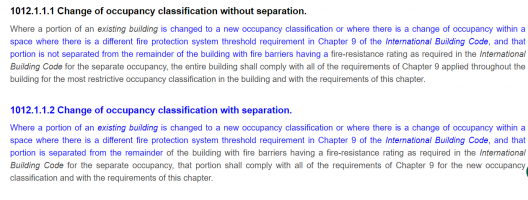fungineer
Registered User
Code 2015 IEBC w/ Wisconsin Amendments (SPS 366).
Existing condition:
An existing, unsprinklered, (single) building of 30,000 sq. ft. is has mixed unseparated S-1 & B occupancies. This is a single tenant with an occupancy certificate for both uses. This has been considered a "legally existing non-conforming" for the amount of S-1 compared to the current IBC code. My understanding is that it was legally built under permit previously into this condition. Approximately 9,000 sq. ft. of the building is used similar to B (offices) and the remainder as combustible storage/warehousing.
Proposed work:
Alter the layout to create offices and rearrange the space, including changing approximately 5,000 sq. ft. of S-1 space into B use.
Although the S-1 and B spaces are non-separated currently, the actual use of the space has changed so it dose still appear to be a partial change-in-occupancy classification. IEBC 2015 1001.2.2 states that 1012 would apply.
Additionally, the following other changes will occur:
(2) fire barriers will be constructed creating (3) separated occupancies each approximately 10,000 sq. ft. within the building: (2) Mixed S-1/B and (1) S-1 only. This fire barriers are 2-hour rated, which meets IBC 508.4, but they are not 3-hour which would be required for IBC 707.3.10, thus it would remain a single fire area of 20,000 sq. ft.
Specific items for discussion:
IEBC 1012.2.1 states: "Where a change in occupancy classification occurs......that requires an automatic fire sprinkler system to be provided based on the new occupancy in accordance with Chapter 9 of the IBC, such system shall be provided throughout the area where the occupancy occurs" (See snippet for unapplicable portion).

However, IEBC 1012.2.

In the proposed situation, the separated occupancies (10,000 sq. ft.) would still be mixed-use B/S-1.
As such, the questions area these:
1) Within the (2) 10,000 sq. ft. separated areas, which include a Change of Use from S-1 to B., are sprinklers required?
Related Discussion Items:
a) [No sprinklers are required for the B offices themselves per IBC 903.
b) Due to the existing S-1, the change of use still occurs within a fire area where sprinklers would be required by IBC 903.2.9 (1).
c) Is it correct to read the verbiage of 1012.2.1 in combination with 1012.1.1.1 require the sprinklers?
d) Alternatively, is the general (IEBC 702.1) provision to make the building "no less safe" applicable here whereas the change from S-1 to B has actually made the building safer, or at least no less safe". (I would assume no because this is a change in use, not just an alteration, so additional requirements apply as noted above).
2) Per the verbiage in the commentary for 1012.1.1.2, it talks about providing occupancy separations per 508.4 to limit the extent of change-in-use requirements, including "...this shall also relate to exceeding the fire area..."
a) My understanding is that this would mean that sprinklers (if required in 1) would only be required in the (2) separated areas, but not the 3rd unchanged S-1 area. Do others agree?
Existing condition:
An existing, unsprinklered, (single) building of 30,000 sq. ft. is has mixed unseparated S-1 & B occupancies. This is a single tenant with an occupancy certificate for both uses. This has been considered a "legally existing non-conforming" for the amount of S-1 compared to the current IBC code. My understanding is that it was legally built under permit previously into this condition. Approximately 9,000 sq. ft. of the building is used similar to B (offices) and the remainder as combustible storage/warehousing.
Proposed work:
Alter the layout to create offices and rearrange the space, including changing approximately 5,000 sq. ft. of S-1 space into B use.
Although the S-1 and B spaces are non-separated currently, the actual use of the space has changed so it dose still appear to be a partial change-in-occupancy classification. IEBC 2015 1001.2.2 states that 1012 would apply.
Additionally, the following other changes will occur:
(2) fire barriers will be constructed creating (3) separated occupancies each approximately 10,000 sq. ft. within the building: (2) Mixed S-1/B and (1) S-1 only. This fire barriers are 2-hour rated, which meets IBC 508.4, but they are not 3-hour which would be required for IBC 707.3.10, thus it would remain a single fire area of 20,000 sq. ft.
Specific items for discussion:
IEBC 1012.2.1 states: "Where a change in occupancy classification occurs......that requires an automatic fire sprinkler system to be provided based on the new occupancy in accordance with Chapter 9 of the IBC, such system shall be provided throughout the area where the occupancy occurs" (See snippet for unapplicable portion).

However, IEBC 1012.2.

In the proposed situation, the separated occupancies (10,000 sq. ft.) would still be mixed-use B/S-1.
As such, the questions area these:
1) Within the (2) 10,000 sq. ft. separated areas, which include a Change of Use from S-1 to B., are sprinklers required?
Related Discussion Items:
a) [No sprinklers are required for the B offices themselves per IBC 903.
b) Due to the existing S-1, the change of use still occurs within a fire area where sprinklers would be required by IBC 903.2.9 (1).
c) Is it correct to read the verbiage of 1012.2.1 in combination with 1012.1.1.1 require the sprinklers?
d) Alternatively, is the general (IEBC 702.1) provision to make the building "no less safe" applicable here whereas the change from S-1 to B has actually made the building safer, or at least no less safe". (I would assume no because this is a change in use, not just an alteration, so additional requirements apply as noted above).
2) Per the verbiage in the commentary for 1012.1.1.2, it talks about providing occupancy separations per 508.4 to limit the extent of change-in-use requirements, including "...this shall also relate to exceeding the fire area..."
a) My understanding is that this would mean that sprinklers (if required in 1) would only be required in the (2) separated areas, but not the 3rd unchanged S-1 area. Do others agree?

